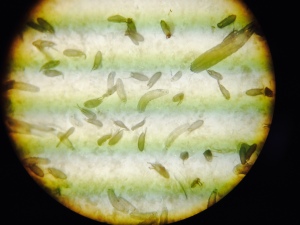Day 34: Inquiry is Hard
Today was supposed to be “the day”.
After all this time observing and working together to cross our flies it was the student’s turn to choose their initial research question that would guide them from here on.
*crickets*
So this is one of the hardest things for me that requires patience on my part. I noticed students beginning to turn off and quit. I had not given them a clear direction. Their direction was to “Choose your question and let that guide your observations and next steps today.” Too vague for them, freshman especially. What do I mean by “choose a question”? So I asked groups at the same lab bench (~4) to share their questions and observations to decide on a group direction. Still not much, so on the fly* I had them share their observations as lab groups on the front board so everyone could see what others had seen.
I spoke each group’s aloud and asked if students had questions about these observations and/or had those groups expound or clarify as well. This helped because students at tables where we were maybe less observant were able to see others had seen abnormalities/more in their flies. The questions that arose from this share out I got were generally superficial, although still important. They knew flies were dying (see: Tep3/Tep3) and that they did not make it to adults so roughly 75% of all my freshman chose “When are the flies dying?” as their direction. The ones that did not noticed something maybe a little more unique and intriguing.
So some groups investigated what makes these trachea so odd and is that what is killing our larva before adulthood? They will be doing some cool biotech stuff later. Stay tuned for that.
After this we broke off into two groups, one trachea group and one “When are they Dying?” group to plan our next steps (Both AP and Freshman, who got a little more help). Each will continue the rest of the week with these experiments and I will detail them on Friday. Until then, enjoy the story below.
Two AP students were surprised to find all of their flies in their cups had died over the weekend. When I asked them what they think had happened they hypothesized old age, disease, mishandling, and undernourishment. “Interesting,” I said, “Do you remember feeding them?” (The apple juice agar plates have yeast paste on them for food.) They shook their heads. “Where was the food located for your flies?” I asked. Silence. Eventually, one of them said on the agar. “Great, so why did you flies die?” Still nothing. So I grabbed their agar plate and flipped it over so now the agar was facing the flies inside the cup instead of towards the outside. *Eyes widen* “We’re idiots” I reassured them they were not, but we discussed when experimenting with live organisms the importance of triple-checking whether we fed them and that the food is located in reach of them. Certainly made my day.
*PUN


